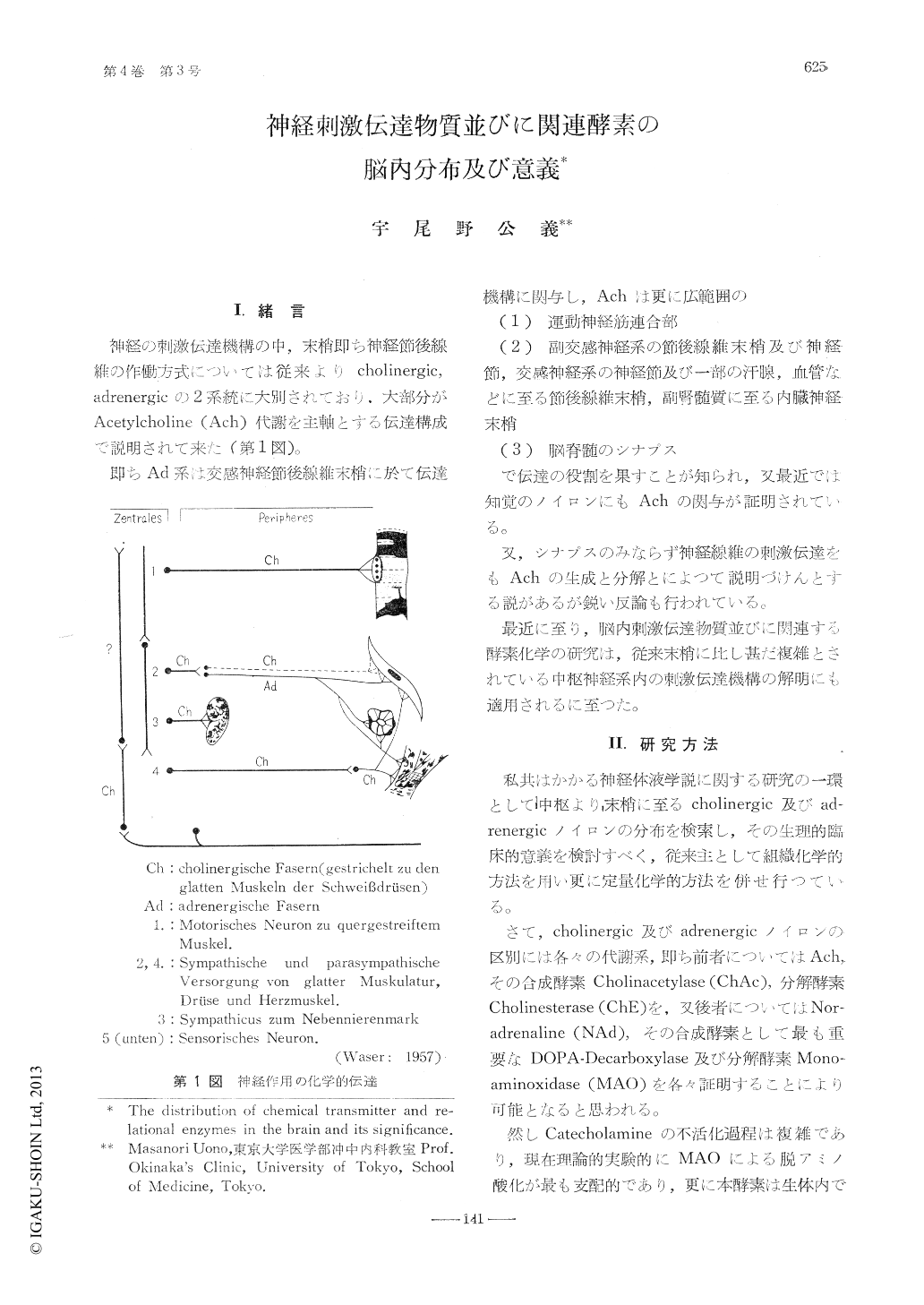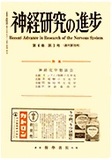Japanese
English
- 有料閲覧
- Abstract 文献概要
- 1ページ目 Look Inside
I.緒言
神経の刺激伝達機構の中,末梢即ち神経節後線維の作働方式については従来よりchobinergic,adrenergicの2系統に大別されており,大部分がAcetylcholine(Ach)代謝を主軸とする伝達構成で説明されて来た(第1図)。
即ちAd系は交感神経節後線維末梢に於て伝達機構に関与し,Achは更に広範囲の(1)運動神経筋連合部(2)副交感神経系の節後線維末梢及び神経節,交感神経系の神経節及び一部の汗腺,血管などに至る節後線維末梢,副腎髄質に至る内臓神経末梢(3)脳脊髄のシナプスで伝達の役割を果すことが知られ,又最近では知覚のノイロンにもAchの関与が証明されている。
The distribution of cholinesterase (ChE), mono-aminoxidase (MAO) activity and noradrenaline-like fluorescing substance (NAd-F1) in the brainhas been studied by using histochemical andmanometrical methods.
1. In the cerebral cortex, ChE activity is weakbut particularly the motor and premotor areasreveal relatively strong activity. And among thenerve cells, ChE activity is by no means uniformlydistributed, but there are activities in variousgrades.. It was found that Betz's giant cells havethe ChE activity.
Whereas MAO activity and NAd-F1 are veryweak in all areas.
2. But in the limbic system including uncinate,hippocampus, cingulate gyrus, amygdaloid nucleusetc., ChE, MAO activity and NAd-Fl is relativelystrong.
3. ChE activity in the basal ganglia especiallyin corpus striatum is strongest in the brain,whereas MAO activity and NAd-F1 are relativelyweak.
4. In the cytoplasma of the ganglion cells inthe paraventricular-and supraoptic nucleus, ChEis observed very densely, and the distribution ofMAO activity and NAd-F1 in these nuclei is aboutthe same as that of ChE activity.
In the stroma of hypothalamus, these enzymesare also observed very actively.
ChE activity in the mammillary body is veryintense as in the caudal nucleus, it seems to bea specific area in the hypothalamus concerning theacetylcholine metabolism.
5. In the human cerebellum, the molecularlayer have strong ChE activity than the granularlayer, and Purkinje cells do not reveal any activity.
Whereas MAO activity in Purkinje cells isvery strong and it seems to suggest that in thesecells the adrenergic mechanisms are at work.
6. ChE activity in the cranial motor nuclei isvery strong. Among the nuclei of autonomicneurous, ChE and MAO activity of the dorsalmotor nucleus of the vagus is very strong, whilethe others also have relatively strong activity.
ChE activity in the substantia nigra and MAOactivity in the red nucleus are very densely ascompared with others.
In the afferent sensony nuclei, ChE activity ismoderate or poor, but exceptionally it is strongin the nucleus of the spinal tract of trigeminalnerve.
7. The anterior horn cells in the spinal cordreveal very strong activity of ChE and it is alsodetected in the ventral root fibers. ChE and MAOactivity in the lateral horn cells are as strong asin the anterior horn cells.
In the posterior horn, ChE activity of substan-tia gelatinosa Rolandi is marked. Reticular for-mation have relatively strong activity as well.
In the cells of Clark column and sacral inter-medio-lateral column reveal strong activity of ChE.
8. Parasympathetic nerves, both pre-and post-ganglionic, demonstrated high ChE activity in theganglion cells and axons (vagal nerve fibers andganglia, ciliary, geniculate, sphenopalatine, oticganglia etc.).
In the ganglion cells of superior, medial cervic-al, stellate ganglia and sympathetic chain, MAOactivity is very intense and ChE activity is alsorelatively strong.
The distribution of ChE, MAO activity andNAd-Fl in the brain is markedly different accord-ing to the areas and sorts of the cells, and thisfact would suggest that there is the functionaldifferentiation in the Ach or NAd metabolism inthe neurons.

Copyright © 1960, Igaku-Shoin Ltd. All rights reserved.


